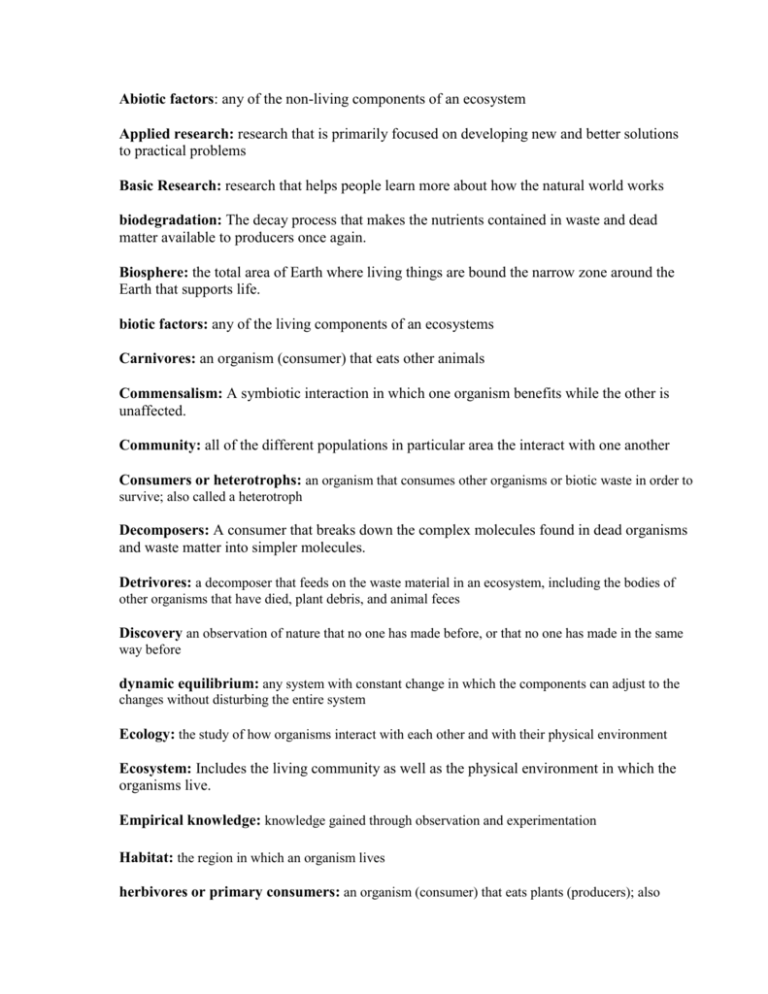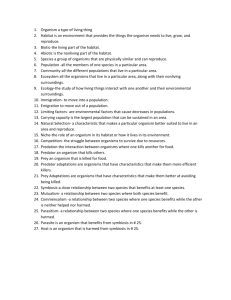Abiotic factors: any of the non-living components of an ecosystem
advertisement

Abiotic factors: any of the non-living components of an ecosystem Applied research: research that is primarily focused on developing new and better solutions to practical problems Basic Research: research that helps people learn more about how the natural world works biodegradation: The decay process that makes the nutrients contained in waste and dead matter available to producers once again. Biosphere: the total area of Earth where living things are bound the narrow zone around the Earth that supports life. biotic factors: any of the living components of an ecosystems Carnivores: an organism (consumer) that eats other animals Commensalism: A symbiotic interaction in which one organism benefits while the other is unaffected. Community: all of the different populations in particular area the interact with one another Consumers or heterotrophs: an organism that consumes other organisms or biotic waste in order to survive; also called a heterotroph Decomposers: A consumer that breaks down the complex molecules found in dead organisms and waste matter into simpler molecules. Detrivores: a decomposer that feeds on the waste material in an ecosystem, including the bodies of other organisms that have died, plant debris, and animal feces Discovery an observation of nature that no one has made before, or that no one has made in the same way before dynamic equilibrium: any system with constant change in which the components can adjust to the changes without disturbing the entire system Ecology: the study of how organisms interact with each other and with their physical environment Ecosystem: Includes the living community as well as the physical environment in which the organisms live. Empirical knowledge: knowledge gained through observation and experimentation Habitat: the region in which an organism lives herbivores or primary consumers: an organism (consumer) that eats plants (producers); also called a primary consumer Host: the organism that is harmed in a symbiotic parasitic relationship; the other organism (parasite) benefits Innovation: the modification of an existing technology to serve a new purpose Invention: the creative development of a new device or process that helps people meet their needs or satisfy their wants limiting factor: the factor that is the most critical in determining the types of organisms that can exist in an ecosystem; an environmental factor that limits the growth, abundance, or distribution of a population of organisms in an ecosystem Mutualism: A symbiotic interaction in which both species obtain some benefit from the interaction. Nutrients: The elements and compounds that organisms must have in order to grow and live; includes water, oxygen, vitamins, minerals, etc. Omnivores: an organism (consumer) that eats both plants (producers) and animals (consumers) Organism: a single living thing; the first and simplest level of organization that ecologists Parasite: the organism that benefits in a symbiotic parasitic relationship; the other organism (host) is harmed Parasitism: A symbiotic interaction where one organism benefits at the expense of another organism, which is often harmed but usually not killed. Phytoplankton: microscopic algae that obtain energy through photosynthesis; they are found at the surface of oceans, seas, and freshwater bodies Population: all of the organisms of the same species that share a habitat; the second level of organization that ecologists study Predation: An ecological interaction that occurs when a predator captures and consumes prey. Predator: an organism that lives by preying on other organisms Predator-Prey cycle: describes the predator–prey relationship in terms of the effects on the size of both populations producers or autotrophs: an organism that makes its own food, usually using energy from the Sun in a process called photosynthesis; also called an autotroph Scientific and technological literacy: A combination of the science related attitudes, skills, and knowledge needed to develop problem-solving, and decision-making abilities. Serendipity: the act of discovering or inventing something useful by accident Symbiosis: A specialized form of interaction between two different species; includes mutualism, commensalism, and parasitism. Technology: the process and the products by which humans develop ways to satisfy some of their needs and wants Traditional ecological knowledge and wisdom: the knowledge, experiences, and wisdom gained over many generations of close interaction with the living and non-living components of the environment Trophic Levels: A group of living things that describes the position of an organism in relation to the order of nutrient and energy transfers in ecosystems.









